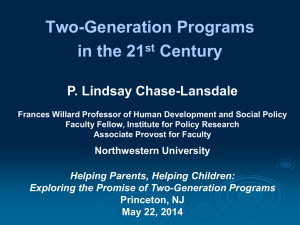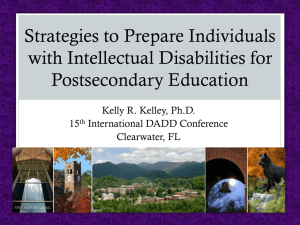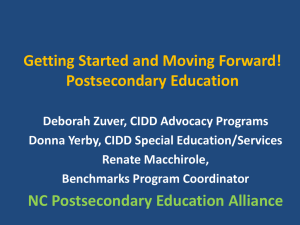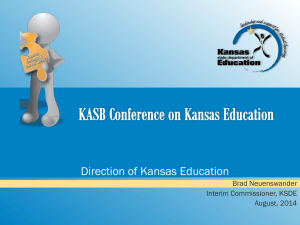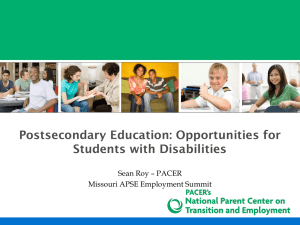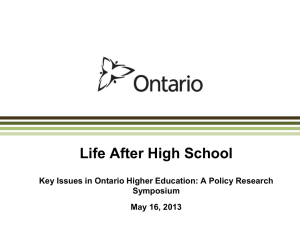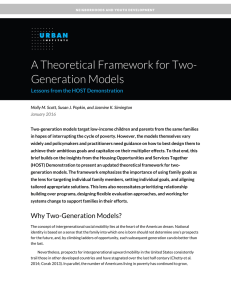2Gen-Strat-Research_King_June-272014
advertisement
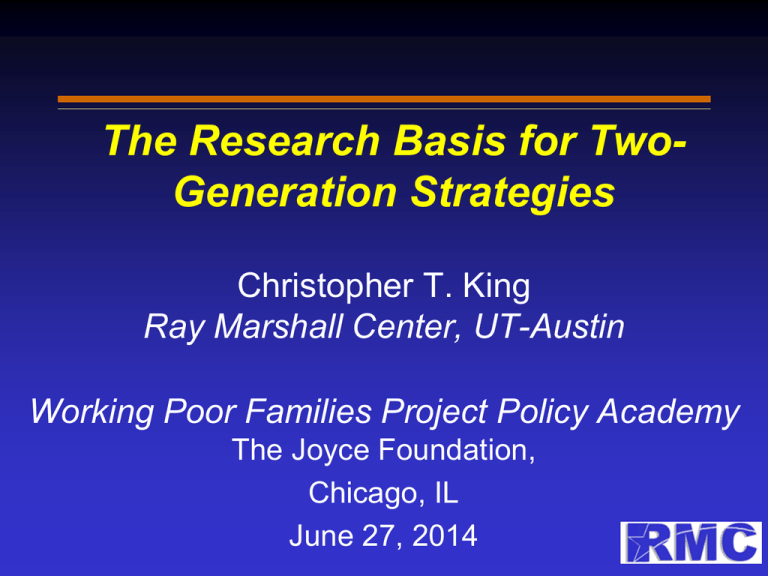
The Research Basis for TwoGeneration Strategies Christopher T. King Ray Marshall Center, UT-Austin Working Poor Families Project Policy Academy The Joyce Foundation, Chicago, IL June 27, 2014 Acknowledgements Collaborators— • Lindsay Chase-Lansdale, Terese Sommer, et al., Northwestern • Aspen Institute’s Ascend Program & Ascend Fellows Funders— • Hirokazu Yoshikawa, NYU • George Kaiser Family Foundation • Jeanne Brooks-Gunn, Columbia • Foundation for Child Development • Jack Shonkoff & Celia Gomez, Harvard • Administration for Children & Families, USHHS • Steven Dow & Monica Barczak, Community Action Program of Tulsa Co. • W.K. Kellogg Foundation Two-Generation Strategies • Wide variation in strategies, from basic parent engagement, parents-as-first-teachers, parenting programs, parent referrals to services, and so on. Quality and intensity are very uneven. • “Two-Gen 2.0” emphasizes substantive human capital investments, i.e., programs intentionally and simultaneously connecting: – High-quality education and job training for parents, and – High-quality early education for their young children – With requisite supports and wrap-around services to ensure their effectiveness. Conceptual Framework* Components Child Quality Early Education (PreK-3rd Grade) Short-term Outcomes • • • • Early literacy & math preparation Improved attendance Career exposure Social/emotional readiness for K-3rd grade Family Support Services Parent Leading-edge Postsecondary Education & Training plus Adult Ed, ESL & Wraparound Services *Building on Chase-Lansdale et al. (April 2011). • Understanding relationship between own and child’s education • Motivation to pursue postsec. education, training & careers • Defined E&T and career goals • Higher rates of postsecondary education and career training enrollment and persistence Framework*… Components Child Quality Early Education (PreK-3rd Grade) Mid-term Outcomes • Academic success in elementary school • Improved social adjustment in elementary school Family Support Services Parent Leading-edge Postsecondary Education & Training plus Adult Ed, ESL & Wraparound Services *Building on Chase-Lansdale et al. (April 2011). • Higher rates of adult basic education (including ESL) • PSE credit accumulation • PSE persistence • PSE completion • Improved parent/child interaction Framework*… Components Child Quality Early Education (PreK-3rd Grade) Long-term Outcomes • Increased academic performance in middle and high school • Increased rates of PSE enrollment, persistence and completion Family Support Services Parent Leading-edge Postsecondary Education & Training plus Adult Ed, ESL & Wraparound Services *Building on Chase-Lansdale et al. (April 2011). • • • • Increased emotional well being Greater life stability Career advancement Improved employment, earnings and family incomes Two-Generation Pathways Haskins et al., in Spring 2014 two-generation issue of Future of Children, describe 6 pathways by which parents and home setting affect child development: 1. Stress 2. Parental Education (including skills training) 3. Health 4. Income 5. Employment 6. Asset Development Points to the need for comprehensive, multi-faceted strategies. Stress & Child Development Thompson (2014), building on brain development (Shonkoff & Phillips, 2001) and child development research, finds— •Marital conflict, domestic violence, child abuse, depression, poverty lead to stress, sometimes extraordinary and unavoidable (“chronic” or “toxic”) stress. •Biological effects of stress undermine children’s ability to concentrate, remember, control and focus their thinking. •Developmental plasticity can help … or hurt. •Parent/caregiver support can offset, buffer stress effects. •Better preventive and ameliorative interventions can improve child/parent/caregiver relations via “integrated biologicalbehavioral approaches.” Parental Education Kaushal’s (2014) review finds— •“Better educated parents have better educated kids.” •Increased parent education has positive causal effects on children’s test scores, health, behavior, and development, as well as on mothers’ own behavior (e.g., teen childbearing, substance abuse) as it affects their children. •Conventional measures of returns to parental education (e.g., income, productivity) understate real returns. •US spends more on education as % of GDP than other OECD nations, but disproportionately on richer children, thus perpetuating inequality. NOTE: US ranks almost last in spending on labor market/training programs, (King & Heinrich, 2011)! Family Health Glied & Oellerich’s (2014) review finds— •“Healthier parents have healthier children,” as result of genetics, as well as environment and behavior. •Key issues include access, insurance and benefits. •Problematic that physicians typically treat parents or children, not the family as a whole. •Health components (e.g., “health home”, nutritional education) not very common in today’s 2-gen programs. Family Income Duncan et al. (2014) find— •Poverty harms child development per 3 theories: family & environmental stress; family resources & investment; and cultural practices. •Causal effects of low income are “moderate”, but timing is key: poverty in early childhood has strongest adverse impacts. •Note MDRC research on impacts of income supplements in US and Canada. •Cash and in-kind income supplements likely have positive effects on child development. Parental Employment Heinrich’s (2014) review finds— •Mixed effects of employment on children, independent of effects of income alone: Plus: increased income/resources, better role modeling Minus: less parenting time, greater stress •NOTE: children whose parents have unstable, low-wage, low-quality jobs without autonomy or benefits are at much greater risk of adverse effects. •Note Yoshikawa et al. (2006) qualitative research on New Hope Project families in Milwaukee. Family Assets Grinstein-Weiss et al. (2014) find— •While poverty-child development links are well documented and researched, connections between parent savings, wealth, and child well-being are not yet as clear. •Low- and moderate-income parents save, if their funds matched by 3rd parties. •Greater assets lead to increased parent education and increased college-going for kids. •More research needed. Experiments, new initiatives are ongoing (e.g., CFED, Colorado DHS). Promise of 2-Gen 2.0 Chase-Lansdale & Brooks-Gunn (2014) review 2-Gen 1.0 and new 2-Gen 2.0 strategies. Major theories: •Continuity & Change: “Early learning begets later learning, skills beget skills.” •Ecological, “proximal environment”: Import of “close-in” environments during kids’ early years, school and home. •Risk & Reslience: Kids can bounce back, thrive in face of adversity with internal and environmental “protective factors”. Interventions must be multi-level, tailored, focused on multiple competence domains, lasting. •Human Capital: education and skills investments lead to greater productivity, jobs, earnings over time. Promise of 2-Gen 2.0 … 2-Gen 1.0 (1980s, 1990s) produced modest effects but mainly added parenting, other low-intensity services to ECE or served mainly welfare mothers adding child care. 2-Gen 2.0 (late 2000s), starting with Tulsa’s Career Advance®, build on much improved workforce and postsecondary approaches. Substantively very different: •Simultaneous human capital investment for wide range of low-income parents and children in same program. •Intensive postsecondary education and sectoral training with career pathways, stackable credentials. •Workforce intermediaries with employer engagement. •High-quality ECE centers. Rigorous Sector Evaluations • Experimental evaluation of Per Scholas (NYC); Jewish Vocational Services (Boston); & Wisconsin Regional Training Partnership (Milwaukee) (Maguire et al., 2010). • Quasi-experimental Capital IDEA (Austin) evaluation & ROI analysis (Smith et al., 2012; Smith & King, 2011). • Experimental evaluation of Comprehensive Employment Training (CET) Replication, a sectoral, career pathway youth program (Miller et al., 2005). • Experimental evaluation of Year Up, career pathway, sectoral, bridge program for youth (Roder & Elliott, 2011 & 2014). • Quasi-experimental I-BEST ‘bridge’ program evaluation (Zeidenberg et al., 2010). Program Participation Effects Program effects significant and quite large: • Participation in E&T services was 32% points higher for participants in sectoral programs relative to controls. • CET youth received 145 more hours of training and earned credentials at rate 21% points above controls. • Year Up participants were 13% points less likely than controls to have attended college in 4 years after random assignment. • I-BEST participants experienced a 17% point increase in services, a 10% point increase in college credits, and a 7.5% point increase in occupational certifications 3 years after enrollment. No significant effects on AA/AS degrees. Labor Market Impacts Meaningful, significant, lasting impacts on participant employment, earnings and associated ROI. Employment • With exception of Year Up and I-BEST, participation associated with statistically significant increases in employment from two to 7.5 years post-program. • Even in programs that did not boost overall employment rates (e.g., Year Up), participation led to increased employment in the targeted sectors (healthcare, IT), typically in much better jobs. Labor Market Impacts … Earnings. Impacts of 12-30% points 2 to 7.5 years post enrollment. •WTRP participants earned 24% more than controls over 2 years, largely from working more hours and earning higher wages; more likely to work in jobs paying $11, $13/hr than controls. Similar results for JVS, Per Scholas. •Capital IDEA participation led to 12-13% point earnings increases, increased (monetary) UI eligibility by 11-12% points nearly 8 years post. Low-income workers able to become eligible for ‘first-tier’ safety net. •Year Up participant earnings exceeded controls by 32% points 3years post, largely from working full-time rather than part-time jobs, jobs paying higher wages. Labor Market Impacts … Source: Smith & King, 2011. Associated ROI Effects Source: Smith & King, 2011. Qualitative Evidence • Too soon to capture measurable impacts from 2gen 2.0 efforts. Early outcomes just emerging from Tulsa’s CareerAdvance®. • Partner (e.g., Tulsa Community College, Union Public Schools), CAP, CareerAdvance® and employer interviews are very encouraging. • Participant focus groups and interviews since 2010 tell us the program and its components are largely on the right track. A few examples … Peers, Coaches & Staff Support “We constantly have the support not only from our classmates but also from our teachers and our coach. You know, and when I was in college before, it was just me against the world basically you know. So if I dropped out, nobody cared. It was just, I was only just disappointing myself. Now if anybody is missing too much class we’d call them and are like, you know ‘Where are you at? Come to class.’” Role Modeling “I’m the first person to even go to school. So it feels good to me to just know that I’m gonna make a better, like pave a better path for my son. The chances of him going to school if I complete school are so much higher. And that’s you know, not only will I create a better life for him as a child, but it’ll give him some encouragement and motivation, and I can be a better role model for him to go to school when he’s older. So it makes me feel a lot better I think.” State Policy Implications Per King et al. (2013), states should: •Target families rather than just adults or children for services •Adopt and foster proven sectoral and career pathway strategies for adults •Provide funding for workforce intermediaries to better engage employers and providers in postsecondary services •Adopt and support contextualized ‘bridge’ models for adult education and ESL services State Policy Implications … • Ensure that colleges, esp. 2-year, offer cohort and peer supports, career navigators/coaches to ensure persistence and credential completion • Take advantage of opportunities to provide quality early childhood education in lieu of typical childcare services for parents served in workforce and education programs • Pursue asset building strategies to increase parents’ capacity to support their children while in workforce and education programs and beyond Concluding Observations Passive, market-based models simply will not help families become economically self-sufficient or break the cycle of inter-generational poverty. Some state policy and program frameworks — and associated local institutions — are much better structured to help families get the services they need to succeed. States not so well structured can take action to improve their capacity for action, without federal legislation. Pending federal legislation (e.g., the Workforce Innovation Opportunity Act) may be more supportive of 2-generation strategies and their evidence-based components. Greater investment is needed at all levels. For More Information Christopher T. King, Director Ray Marshall Center LBJ School of Public Affairs The University of Texas at Austin 512.471.2186 ctking@raymarshallcenter.org www.raymarshallcenter.org

